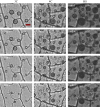Physico-chemical characteristics of evaporating respiratory fluid droplets
- PMID: 29491178
- PMCID: PMC5832737
- DOI: 10.1098/rsif.2017.0939
Physico-chemical characteristics of evaporating respiratory fluid droplets
Abstract
The detailed physico-chemical characteristics of respiratory droplets in ambient air, where they are subject to evaporation, are poorly understood. Changes in the concentration and phase of major components in a droplet-salt (NaCl), protein (mucin) and surfactant (dipalmitoylphosphatidylcholine)-may affect the viability of any pathogens contained within it and thus may affect the efficiency of transmission of infectious disease by droplets and aerosols. The objective of this study is to investigate the effect of relative humidity (RH) on the physico-chemical characteristics of evaporating droplets of model respiratory fluids. We labelled these components in model respiratory fluids and observed evaporating droplets suspended on a superhydrophobic surface using optical and fluorescence microscopy. When exposed to continuously decreasing RH, droplets of different model respiratory fluids assumed different morphologies. Loss of water induced phase separation as well as indication of a decrease in pH. The presence of surfactant inhibited the rapid rehydration of the non-volatile components. An enveloped virus, ϕ6, that has been proposed as a surrogate for influenza virus appeared to be homogeneously distributed throughout the dried droplet. We hypothesize that the increasing acidity and salinity in evaporating respiratory droplets may affect the structure of the virus, although at low enough RH, crystallization of the droplet components may eliminate their harmful effects.
Keywords: aerosol transmission; crystallization; influenza; mucus; phase separation; relative humidity.
© 2018 The Author(s).
Conflict of interest statement
We declare we have no competing interests.
Figures






References
-
- Beggs CB. 2003. The airborne transmission of infection in hospital buildings: fact or fiction? Indoor Built Environ. 12, 9–18. (10.1177/1420326X03012001002) - DOI
-
- Sattar SA, Ijaz MK, Gerba CP. 1987. Spread of viral infections by aerosols. Crit. Rev. Environ. Control 17, 89–131. (10.1080/10643388709388331) - DOI
Publication types
MeSH terms
Substances
Grants and funding
LinkOut - more resources
Full Text Sources
Other Literature Sources

